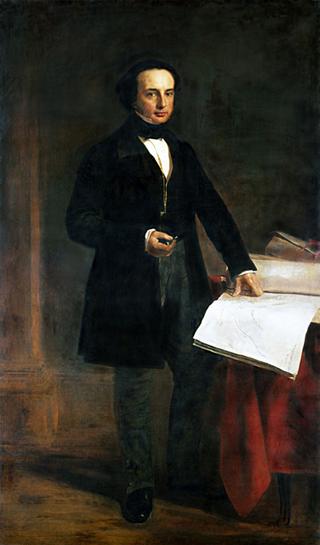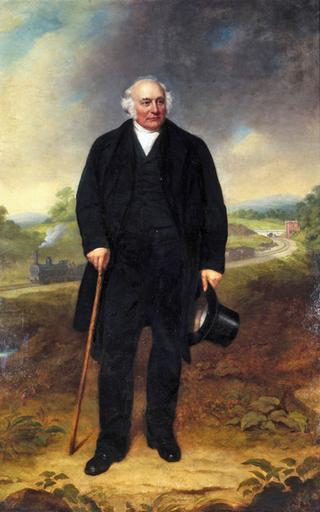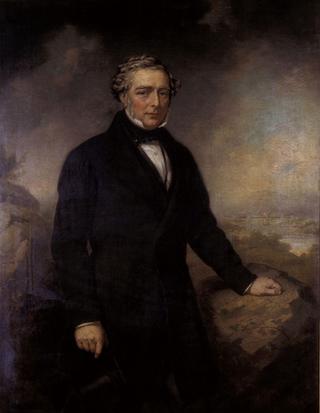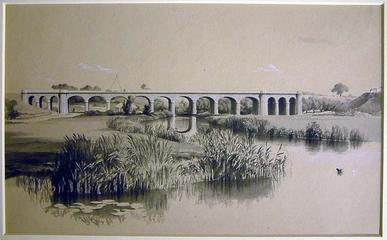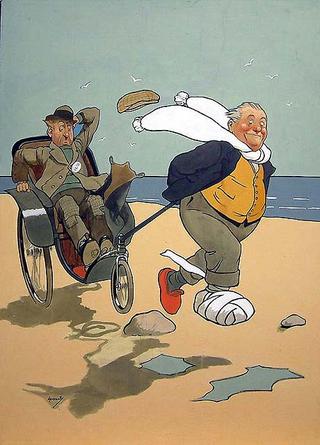
Watercolour of Soane (Koilwar) Bridge mid-construction
- Made:
- 1860-02-25

Painting, watercolour on paper, Soane Bridge works from head of Eastern incline, 25th February 1860, by B S, 1860. Depicts the construction of the Soane or Koilwar Bridge over the River Sone on the East Indian Railway. The painting shows the building of the bridge's brick piers, which recede into the distance. In the foreground stands an Indian guard, holding a sword. Alongside the bridge a contractor's railway crosses the river. Unframed. From the collection of George Turnbull, the railway's Chief Engineer.
When surveying potential routes for the East Indian Railway, one of the key problems facing George Turnbull was crossing the Sone (or Son) River, the largest tributary of the Ganges. Turnbull visited the river in February 1851, spending three hours examining it with a view to the proposed bridge. Using his pocket-sextant and a measuring tape, he measured the width of the river as 5,350 feet. Turnbull’s rough calculation was in fact very accurate: once built, the bridge’s length was 5,280 feet (a little over 1.6km).
Bridge designs were in-hand by October 1854, and in December 1854 bore-holes were made in riverbed to find out the type of ground below. Yet deliberations regarding design continued well into spring 1856. Turnbull suggested that rectangular blocks would sink into the sand and be prone to cracking. His idea was to use circular blocks, which would be equally supported all the way round, and so less likely to crack. After long discussions with other engineers, a trial block was installed in the riverbed. Results were positive, and Turnbull’s circular block design went on to be used not just for the Soane Bridge but also for the Hullohur Bridge and other large bridges on the East Indian Railway.
The bridge’s first brick was laid on 4 April 1857, however the bridge was destroyed twice during construction, first in the Indian Rebellion of 1857 and then again in another rebellion the following year. These uprisings were against the rule of the British East India Company and resulted in the British government taking over direct political control, beginning a period known as the British Raj.
The watercolour’s artist, Bernhard Schmidt, arrived in India in April 1857. At first he served under Samuel Power, who led the bridge construction, but Schmidt took over after Power returned to England. By late 1860 Turnbull had grown anxious about the bridge’s progress. His fears were to prove unfounded, because Schmidt led the works ‘in excellent fashion’ for the next two years. The bridge was completed by November 1862 and was tested with locomotives the following month. It remained the longest river bridge on the Indian subcontinent until 1900, when the 3km Upper Sone Bridge (Nehru Setu) was completed 100km upriver. The Soane Bridge (now known as the Koilwar Bridge) remains the oldest operational railway bridge in India. It featured in the 1982 Oscar-winning film Gandhi.
The British introduced railways in India to satisfy the mounting economic and military needs of their colonial administration. They hoped that the new technology would foster an increased sense of collective identity by making it easier to travel quickly between distant regions. They also hoped the railways would socially ‘improve India’ by instilling a sense of punctuality among Indians, a quality British colonialists believed Indians lacked. The racist stereotypes underpinning these intentions, and the interconnected idea that technology could trigger social change, were common beliefs in nineteenth-century British society.
Details
- Category:
- Pictorial Collection (Railway)
- Object Number:
- 2017-7088
- Materials:
- paper and watercolours
- type:
- painting, watercolour
